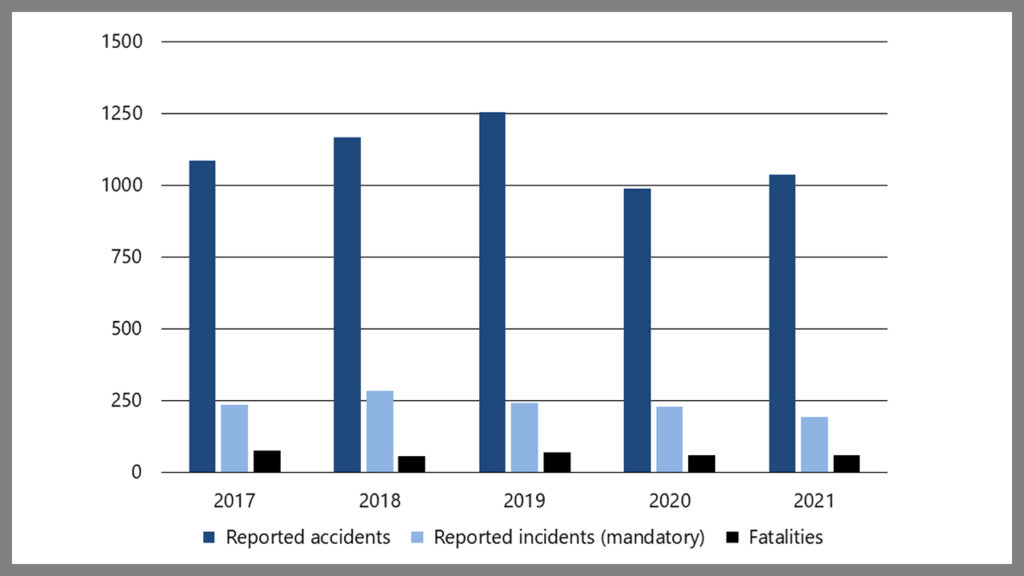
TSB Rail Safety 2021-2022 Year in Review
Written by William C. Vantuono, Editor-in-Chief
In accordance with subsection 13(3) of the Canadian Transportation Accident Investigation and Safety Board Act, Canada’s Transportation Safety Board (TSB) has submitted its Annual Report to Parliament for the period covering April 1, 2021 to March 31, 2022.
The Report (downloadable below) covers rail, air, marine and pipelines. Following are excerpts from the Rail Transportation section.
TSB received 1,232 reports of rail transportation occurrences in 2021 (1,038 accidents and 194 incidents), including 60 fatalities. The 1,038 accidents represent a 5% increase from 2020 but a 3% decrease from the 10-year average of 1,071. The 60 rail transportation-related fatalities reported in 2021 are the same as in the previous year but below the 10-year average of 71. Among the fatalities, 42 involved trespassers, compared to 40 in 2020 and the 10-year average of 40. The number of crossing accident fatalities, 16, decreased in 2021 compared to 2020’s 18 and is lower than the 10-year average of 23. TSB “is conducting ongoing research to better understand crossing accidents in the winter in a safety issue investigation.”

Among all rail transportation accidents, 86 involved dangerous goods. This is up from 82 in 2020 but is lower than the 10-year average of 125. Two accidents in 2021 resulted in dangerous goods being released.
There were 194 rail transportation incidents reported to the TSB in 2021, a 15% decrease from 2020’s 229, and a 30% decrease from the 10-year average of 277) There were 109 incidents involving movements that exceeded limits of authority, accounting for 56%of all rail transportation incidents in 2021—40 less than in 2020 and below the 10-year average of 129.
TSB defines accident rate as “a measure of rail transportation safety.” According to TC data, 2021 main line (non-yard) rail activity decreased by 1% from 2020. The main line accident rate in 2021 was 4.8 accidents per million train-miles, up from 2.8 in 2020 and above the 10-year average of 2.5. As in 2019 and 2020, a portion of main line accidents in 2021 consists of “an unusually high number of right-of-way fires reported to the TSB in 2021, 137, which primarily accounts for the increase in the main line accident rate.”

TSB staff deployed to 11 rail transportation occurrences in 2021–22, an increase from 2020–21, began 8 investigations and completed 9.
As a result of its investigation report into the 2019 derailment of 2 locomotives and 99 cars of a 112-car Canadian Pacific grain train, in which the three crew members were fatally injured near Field, B.C., the Board issued three recommendations to make train operations in cold weather safer through mountainous territory. TSB “is calling for enhanced test standards and requirements for time-based maintenance of brake cylinders on freight cars operating on steep descending grades in cold ambient temperatures; implementation of a schedule for the installation of automatic parking brakes on freight cars; prioritizing the retrofit of cars used in bulk commodity unit trains in mountain grade territory; and CP to demonstrate to TC that its safety management system can effectively identify hazards arising from operations using all available information, including employee hazard reports and data trends; assess the associated risks; and implement mitigation measures and validate that they are effective … Following the occurrence, TSB sent rail safety advisory letters to Transport Canada (TC) on the prevention of uncontrolled movements for trains stopped in emergency on grades of less than 1.8%, on air brake system inspection and maintenance on grain hopper cars used in CP unit train operation, and on the effectiveness of the No. 1 brake test. TC took several initiatives after the occurrence, such as approving the railway industry’s proposed new Rule 66 of the Canadian Rail Operating Rules (CROR) as well as the use of automated train brake effectiveness technology in lieu of No. 1 air brake test requirements on CP’s unit grain trains operating between points in Western Canada and the Port of Vancouver. Following the occurrence, CP proceeded, among other things, to remove over 5000 grain cars from service for repair.”
TSB’s investigation report into the collision of a VIA Rail passenger train and an unoccupied CN hi-rail vehicle in Les Cèdres, Quebec “highlights the importance of implementing physical defenses to prevent employee fatigue from contributing to occurrences.” The passenger train was operating east at the authorized 95 mph speed on the north main track of the CN Kingston Subdivision. The two engineers on board the locomotive noticed a bright light in the distance. When the operating locomotive engineer realized that the light appeared to be coming from rolling stock on the same track as the train, a full-service air brake application was initiated and the locomotive horn and bell were sounded. A few seconds later, the train, still traveling at nearly 83 mph, struck an unoccupied pick-up truck type hi-rail track unit at Mile 30.5, in the municipality of Les Cèdres. There was no derailment and no one was injured. An analysis was conducted to assess the fatigue of the signal maintainer in this occurrence. It was determined that the employee had probably accumulated a sleep debt, a condition that contributes to fatigue, given his numerous consecutive night shifts involving long hours and the fact that he was sleeping during the day, when quality of sleep is reduced. “As this occurrence demonstrates, work schedules that increase the risk of fatigue in railway employees may create high-risk situations with potentially serious consequences. Fatigue poses a risk to transportation safety because of its potential to degrade several aspects of human performance … Following the occurrence, TC sent a notice to CN indicating that the measures implemented to prevent events such as this occurrence had been deemed insufficient. Later, CN informed TC that it had developed an employee assessment tool to check their knowledge of the regulations governing the protection of track work.”
TSB said that of the nine responses to rail transportation safety recommendations the Board assessed or reassessed in 2021–22, “none were closed as Fully Satisfactory,” with 4 obtaining Satisfactory Intent and 5 Satisfactory in Part.
TC continued its work to update the regulatory regime for railway employee qualifications and training. “This means that, while the action is not yet sufficiently advanced to reduce the risks to transportation safety, progress is being made toward addressing the safety deficiency identified in Recommendation R18-02 calling for training and qualification standards for railway employees in safety-critical positions. The Board therefore reassessed the response to the recommendation as showing Satisfactory Intent.”
TSB also reassessed the response to Recommendation R14-05 on the auditing of safety management systems, one of the recommendations issued as a result of the TSB’s investigation into the 2013 runaway and main-line derailment in Lac-Mégantic, Quebec. TC “indicated that it completed audits of all federally regulated railway companies’ safety management systems and that it is in the early stages of implementing a targeted audit framework for measuring the effectiveness of the safety management system processes. The Board is encouraged by the progress and therefore considers this response to show Satisfactory Intent.”
Regarding Recommendation R13-01 on physical fail-safe train controls, TSB “considers the responses from the Railway Association of Canada and TC to be Satisfactory in Part and strongly encourages both organizations to accelerate the pace of ETC (Enhanced Train Control) implementation. The underlying safety deficiency was identified as a result of the TSB’s investigation into a rear-end train collision more than 20 years ago. For all active recommendations, the TSB will continue to monitor the progress of planned actions and call for action to reduce or eliminate these deficiencies.”
Download the full TSB report:



